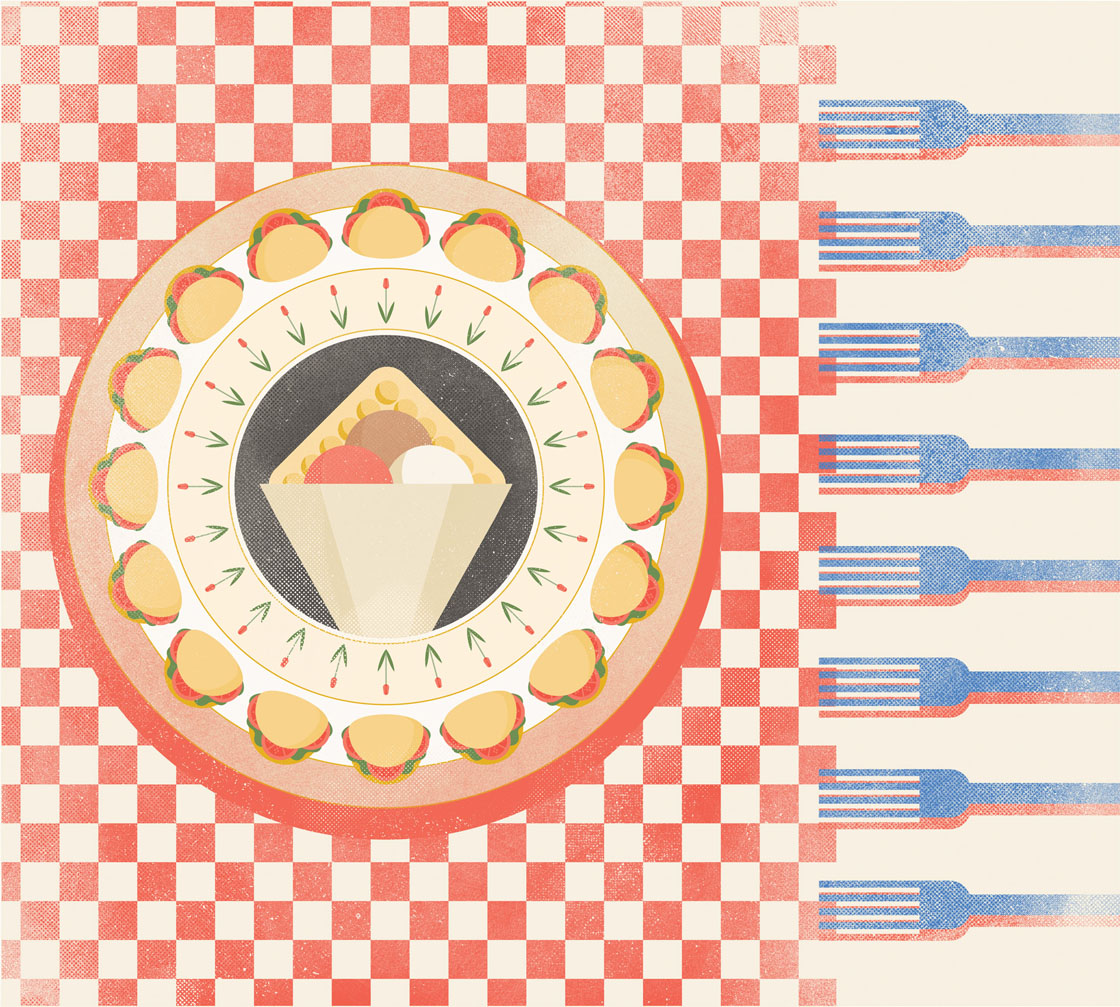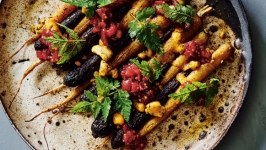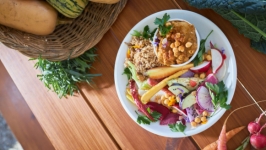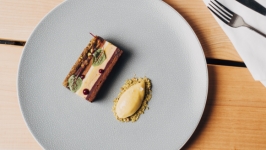Making the Unfamiliar Familiar
Food is a way of relating to one another. In this time of increasing division, food can be a literal and figurative olive branch (or at the very least, an olive oil-based consumable). Despite it being a point of connection, it can also lead to stigmatizing experiences. I recently had an encounter at my day job with a friendly individual who introduced himself and, in the same beat, asked whether I had tried the nearest Indian lunch buffet.
“I love butter chicken,” he remarked excitedly.
“I haven't, but I’ll have to check it out.” I responded. I appreciated his enthusiasm at sharing his love for food — a characteristic that we clearly share (my wife and I spend a lot of our free time posting about our favourite food on Bytown Bites). However, I assume that he had leapt to this conversational thread based on the visible patch of brown skin above my mask. Brown skin attributed to my Sri Lankan heritage.
With a million people in Ottawa, you would assume that this experience (or that time where a local farmer congratulated me as the “second brown person of the season”) would be rare. However, when you look at the demographics of our city, you realize that more than two-thirds of Ottawans identify their ethnicity as “European” (based on 2016 data). Of visible minority groups, six per cent were Black, five per cent were Aboriginal, followed closely by Chinese, Arab and South Asian. By contrast, that dominant number of Europeans is 48 per cent in Toronto, where I grew up.
I can’t say this wouldn’t happen in another city, but it feels as though it would be something that happens less often as cities grow, and as representation increases. It is part of the reason why representation is so important, not just as a point of reference, but also as aspirational targets for those from similar communities. When there is less representation, there is less familiarity, and there may be clumsier attempts at finding these points of connection. Food can be a way for people from various cultural backgrounds to intersect and interact. Food lovers learn about new cultures through food, and restaurant owners and chefs learn about the demographics of their city based on what questions they’re asked and what people come back for.
I had never had an arepa, a style of cornmeal cake originating in Venezuela and Colombia, until stumbling upon them at Gooney’s, a Centretown sandwich shop. I was curious about how they came to be on their menu. I spoke with Isabella Granati, daughter of the family-run business, about whether this was something they initially set out to showcase to Ottawans.
“We actually came to Canada 10 years ago and bought Gooney’s, with the name, as a sandwich and salad restaurant,” Granati says.
Over time, they learned of an arepa-sized gap in Ottawa and started doing weekly “Arepafest” events that were initially targeted to the Latin community though newspaper advertisements and word of mouth. Based on the reception, the family decided to add them to the daily menu, with a collection of traditional fillings such as shredded beef or marinated pork. These became a hit, but the owners also learned of a desire from their patrons for breakfast arepas, a fusion of ingredients such as scrambled eggs, bacon and cheese, which not-so-surprisingly also paired well with Gooney’s cornmeal arepas. This kind of cultural adaptation, with a reciprocal conversation between patrons and chefs, is what led to creations such as the “Cadillac” arepa (scrambled eggs, bacon, feta cheese, avocados and coriander sauce), named after a customer who always asked for the addition of avocado and exclaimed, “Oh my God, I feel like I'm in a Cadillac when I eat this.”
This evolution of food, and the ways restaurants try to adapt, made me wonder about how receptive Ottawans are to the “traditional” servings from various restaurants. Gooney’s owners say Ottawa has given their arepas a warm reception, and, surprisingly, their most “traditional” offerings are their most popular. This might indicate that Ottawans are curious about new foods, but they might also require a gentle nudge to expand out of their comfort zones. Is this nudging something that restaurants owned by Black, Indigenous and People of Colour, have to prioritize more than their Caucasian counterparts?
A gap in the market is also what inspired Sarath Teegavarapu to open NH44, a restaurant specializing in regional Indian street food that he ended up having to close as a result of COVID-19. He came to Ottawa as an international student in computer science, and would drive to Toronto to get his fill of menu items such as pani puri (fried hollow dough balls, filled with a mixture of flavoured water, chutney, chilies, chaat masala, potatoes, onion or chickpeas). He left his role as an Android app developer to join a kitchen, and eventually decided to branch out on his own.
Bringing the street food of India to Ottawa did come with challenges. There was the lack of certain ingredients, which were more readily found in cities such as Toronto. And, he needed to reduce the recipes’ initially intended spice level. They also needed to answer to clients who would ask, “where is the saag paneer?” or “where are the samosas?”
“From a financial point of view, we wanted to have them [familiar dishes]. But at the same time, we wanted to be different from the other restaurants.” Despite these apparent barriers, Teegavarapu pushed through. He recently closed NH44 to open Vivaan, a restaurant specializing in similarly regional foods with more modern plating, in a more central location on Preston Street.
“I will have completely new dishes to introduce to Ottawa.” At the same time, he has had to adapt by making the “newer dishes” appetizers and “playing it safer” on the main dishes.
“There’s something in this industry that pulls you forward [to] do something new… I think it’s the love for food.” He has been pleasantly surprised to hear requests for some of NH44’s menu items at his new restaurant and still gets a kick out of customers enjoying a dish while exclaiming that it’s a new experience. He notes that there is a limitation to how much he feels he can experiment, though Ottawans do seem to have the appetite for it. The time commitment and intention of educating the public on their food is something he and Liz Mok, of Moo Shu Ice Cream & Kitchen, highlighted as a necessary consideration in coming up with menus for an Ottawa audience. Mok recalls starting her business at farmers’ markets with ice cream flavours that were well known to her Chinese upbringing, such as yuzu, black sesame, Hong Kong milk tea and fermented tofu. Customer interactions tended to require long explanations about what these flavours tasted like, even for ingredients she had thought were known entities. This lack of familiarity eventually became something she had to prepare for, recalling that she settled on the fact that black sesame “kind of tastes like peanut butter.”
With the opening of her shop and its growing success, she has learned to adapt by balancing her menu with a few staples that require less explanation and two to three flavours that can be more experimental or unconventional. Despite making a name for herself with these flavours, she still has customers who are shocked when there’s “no vanilla” (though there has been one featuring sustainably sourced vanilla from a Hawaiian producer in recent months).
When there is a lack of representation, it can lead customers trying to classify things to better comprehend them. Mok notes that it is not uncommon for her to be asked, “Is this Asian ice cream?” or to be complimented for her “creative” use of certain ingredients, even when they’re used in well-established ways (such as the aforementioned use of black sesame). This type of praise can sometimes overshadow her inventive efforts to flavour ice cream with ingredients such as bread yeast or black olive ganache. The issue of classification can also pigeonhole businesses in ways that are not entirely specific to their offerings.
A common thread to businesses that push past that initial customer reluctance and resistance to something different, it seems, is the reward of broadening horizons. As Mok describes, “When you have to describe what shiso is for the 1,000th time and your mouth gets dry, it can make you wonder why you do this, but then I taste it and remember oh yeah, I love this and others do, too.”
Chef Jae-Anthony Dougan is a recent addition to the Ottawa food scene. He opened Tingz Restaurant + Bar in March, a modern Caribbean eatery, after selling his successful Montreal restaurant, Seasoned Dreams. He has currently shifted towards pop-ups featuring a range of Caribbean dishes, and intends to re-open his concept in the coming months. The importance of bringing this type of food to Ottawa, and its origins in the dozens of Caribbean countries in the region, is not lost on him. He has made it an emphasis to train his front-of-house staff in what the food means, what it represents and what part of the Caribbean it comes from. “In every culture, you have to teach people what they’re eating and where it comes from. A lot of our food derives from slavery, that’s why we’re heavy on the seasoning… to preserve it.”
He views the problem of representation of his community as being broader than something specific to Ottawa. “There’s a huge void that’s missing in terms of Black chefs. When you look at the full aspect of Caribbean food or even Southern food or Creole food, anything that’s represented by Black culture is not represented that well in Canada.” He hopes that his creative takes on Caribbean food can push the envelope, whether that’s jerk chicken poutine or oxtail ravioli. “I guess what pushes me a lot is my community — to show that our food is popular and is capable of doing something different.”
As our concepts of restaurants and dining out evolve, and as awareness grows of systemic injustices, will consumers themselves make it a point of supporting diverse businesses, emphasizing representation or helping to amplify marginalized voices? There appears to be an opening to expand what people might think of when they think of food from a certain area. Dougan views Ottawa as a place of opportunity for a new restaurant. What seems to drive him, and many of the chefs trying to do something new and perhaps underrepresented in Ottawa, is a desire to change preconceived notions. Recently deemed Canada’s second fastest growing city, Ottawa is sure to continue evolving — hopefully the city’s tastes do, too.









